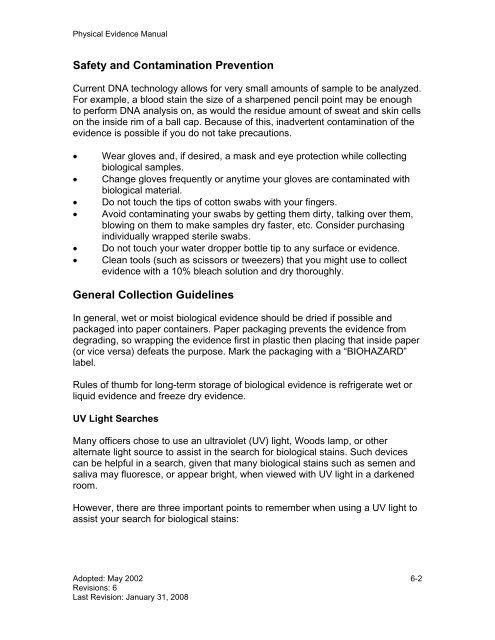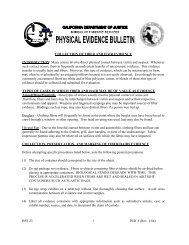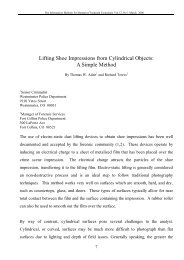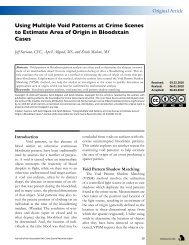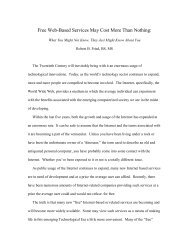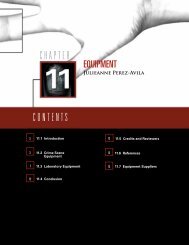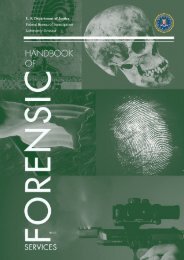PHYSICAL EVIDENCE MANUAL - Crime Scene Investigator Network
PHYSICAL EVIDENCE MANUAL - Crime Scene Investigator Network
PHYSICAL EVIDENCE MANUAL - Crime Scene Investigator Network
Create successful ePaper yourself
Turn your PDF publications into a flip-book with our unique Google optimized e-Paper software.
Physical Evidence Manual<br />
Safety and Contamination Prevention<br />
Current DNA technology allows for very small amounts of sample to be analyzed.<br />
For example, a blood stain the size of a sharpened pencil point may be enough<br />
to perform DNA analysis on, as would the residue amount of sweat and skin cells<br />
on the inside rim of a ball cap. Because of this, inadvertent contamination of the<br />
evidence is possible if you do not take precautions.<br />
• Wear gloves and, if desired, a mask and eye protection while collecting<br />
biological samples.<br />
• Change gloves frequently or anytime your gloves are contaminated with<br />
biological material.<br />
• Do not touch the tips of cotton swabs with your fingers.<br />
• Avoid contaminating your swabs by getting them dirty, talking over them,<br />
blowing on them to make samples dry faster, etc. Consider purchasing<br />
individually wrapped sterile swabs.<br />
• Do not touch your water dropper bottle tip to any surface or evidence.<br />
• Clean tools (such as scissors or tweezers) that you might use to collect<br />
evidence with a 10% bleach solution and dry thoroughly.<br />
General Collection Guidelines<br />
In general, wet or moist biological evidence should be dried if possible and<br />
packaged into paper containers. Paper packaging prevents the evidence from<br />
degrading, so wrapping the evidence first in plastic then placing that inside paper<br />
(or vice versa) defeats the purpose. Mark the packaging with a “BIOHAZARD”<br />
label.<br />
Rules of thumb for long-term storage of biological evidence is refrigerate wet or<br />
liquid evidence and freeze dry evidence.<br />
UV Light Searches<br />
Many officers chose to use an ultraviolet (UV) light, Woods lamp, or other<br />
alternate light source to assist in the search for biological stains. Such devices<br />
can be helpful in a search, given that many biological stains such as semen and<br />
saliva may fluoresce, or appear bright, when viewed with UV light in a darkened<br />
room.<br />
However, there are three important points to remember when using a UV light to<br />
assist your search for biological stains:<br />
Adopted: May 2002<br />
Revisions: 6<br />
Last Revision: January 31, 2008<br />
6-2


